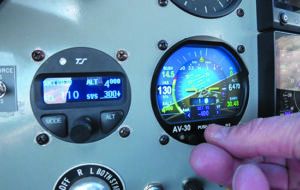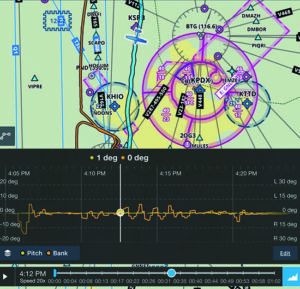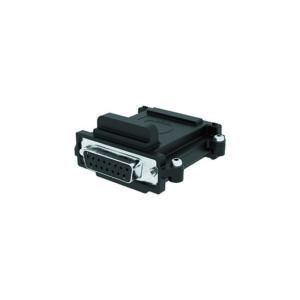After we ran the uAvionix AV-30 installation planning guide in the May 2022 issue of Aviation Consumer, we got some requests for an inflight shakedown report of the instrument’s autopilot and heading interface.
And while the new autopilot interface is only open to experimentals (for now), contributor Marc Cook has been flying behind an AV-30 E in his GlaStar and offered this short flight trial report.
WHICH WAY IS NORTH?
The latest additions to the AV-30 E include functions to control an external autopilot and improvements to the instrument’s ability to act as a standalone directional gyro. On the DG front, uAvionix has recently started enabling an internal magnetometer inside the AV-30’s case. In fact, it’s always been in there, but early units were not electrically connected. All units shipped since December of 2021 have had the magnetometer connected and need only a software update to make them active. It’s important to understand this device is not like typical slaved heading systems.

The AV-30 cannot be programmed to always know which way is north and so it can’t act like a slaved system that always shows magnetic aircraft heading. Devices like the Garmin G5 and GI 275 use external magnetometers that are calibrated in the aircraft; the instruments use a combination of the magnetometer output and other smoothing techniques in software to display a steady aircraft heading always referenced to magnetic north.
Instead, the AV-30 uses the internal magnetometer in addition to its resident MEMS sensors to help determine heading change. Before takeoff (and sometimes during flight), you first have to align the instrument to your conventional compass. The intention is that the combination of the two technologies—where the magnetometer offers a stab at actual heading change and the attitude sensors try to calculate how far and how long the changes have been happening—will result in steady heading indications for the pilot.

In practice, the updated AV-30 does a better job with its mag-reference features invoked than it did without them, but there’s still some drift, and the pilot still had to periodically check the unit’s displayed heading against the compass. And as much as it’s an improvement, once you’ve flown long with a synchronized system, it’s awfully hard to be un-spoiled, so to speak.
The company just announced a compact remote magnetometer that measures just 1.5 by 2.4 inches (including mounting tabs) and stands only 0.7 inches tall. A software update to enable the remote box also promises general performance improvements and the ability to send ADAHRS data through the wireless AV-Link for use with tablet-based mapping apps.
FINALLY, AN AUTOPILOT INTERFACE

The other change in software invokes an RS-232 serial output that can control a TruTrak autopilot. The AV-30 sends basic steering commands in pitch and roll, allowing the pilot to have the autopilot hold heading as we’ll as a selected vertical speed enroute to a preselected altitude. By connecting the AV-30 to a compatible TruTrak/Bendix-
King autopilot, it “spoofs” the Dynon SkyView system (in fact, the TT displays “SkyView” in this mode) with steering commands.
How you control the autopilot depends on which of the three primary screens you’re viewing on the AV-30. All features are available on the AI (attitude) and DG/HSI screens but not on the traffic screen.
For example, in the AI screen with the heading referenced to the internal DG, the autopilot steering commands come a few button-presses in of the main rotary encoder (knobs, to you). First is SET BARO, then DG ADJ, then the HDG BUG; turn to the heading you want and press to acknowledge. To change altitude, press the knob again to scroll through the previous settings until you get to SET ALT.
Unlike the Garmin G5, the AV-30 does not sync near your current altitude, but holds the last altitude you set. Once you’ve changed that value and pushed the button, the SET VS window appears. If you’ve changed the SET ALT value, the SET VS value syncs to whatever the airplane is doing at the time. You can change it from there if you want.
Generally, the autopilot controls work well. The TruTrak autopilot holds the vertical speed we’ll at the AV-30’s commands and levels off smoothly at the set altitude— from above or below. Heading is less successful since the DG is not as steady as a fully synchronized system, so the airplane tends to wander a bit. The early version I flew did not have the ability to drive the heading selection from the GPS ground track, which would be inherently more stable. And, because this is a simpler data stream than the ARINC 429 connection that allows GPS steering, the autopilot tends to overshoot the desired heading then slowly arc its way back to the bug. Finally, the AV-30 does not yet have the ability to pass through GPS navigation commands, so it’s strictly a heading/altitude-hold setup at the moment.
LAYERING IT ON
As I’ve noted in previous reports, uAvionix is trying to do a lot with a compact, lightweight instrument that has only one 15-pin connector on the back. By adding the AV-Link dongle, the AV-30 gets Wi-Fi connectivity (for traffic and software updates currently; more in the future, I’m told), but it still only connects to one GPS source at a time. When you link the AV-30 to the autopilot, you lose the ability to control a tailBeaconX. The only way to have both is to install two AV-30s in your panel, which plenty of people have done. But, for now, two AV-30s don’t talk to each other the way, say, a pair of Garmin G5s or GI 275s can. So you’d have to designate one AV-30 to manage the tailBeaconX transponder and the other to drive the autopilot. And things like heading select or barometer changes won’t be conveyed from one instrument to the other.
I’m told that uAvionix has methods in mind to expand the number of the AV-30’s digital connections to the rest of the airplane, and that’ll be a useful update. What’s more, there’s still some interface refinement to be done, but the company has proven to be a fast developer.
Contributor Marc Cook is the Editor-in-Chief of sister publication
KITPLANES Magazine.




